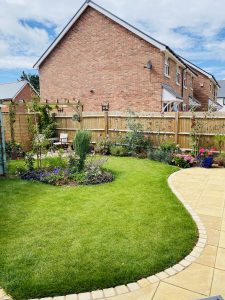 The lawn area tends to be the finishing touch to the majority of projects we create and adds that all-important colour which brings your garden to life.
The lawn area tends to be the finishing touch to the majority of projects we create and adds that all-important colour which brings your garden to life.
There are many different types of turf customers can purchase from various suppliers. These range from your DIY and homeware stores to independent companies that grow and cut their own.
Wherever you are looking to purchase your turf from it is vital that you check for the following signs to ensure that you are giving your new lawn every chance of flourishing.
- A thick layer of soil underneath the grass is critical. This shows that the roll of turf has been cut at a sufficient depth to allow a robust root network to develop. You should be looking for minimum an inch as a general rule.
- The soil and grass of each roll is moist. Quite often we see turf being sold that is drying out and starting to crumble. Your rolls of turf should be pliable enough to fold and stretch without tearing.
- Check your rolls of turf for discolouration. It’s common for turf to start turning yellow if it has been kept rolled up for a few days. Providing the turf is of good quality, this can be laid and providing it is kept watered, will regain the natural green colour in just a few days.
We use only the highest quality turf which is cut in Suffolk and couriered down to our local supplier based in Meon Valley twice a week. From there we always lay the turf on the same day it’s delivered to ensure the best lawns for our customers. However, In extreme weather conditions, the turf will not be cut. Too hot and it dries out during transportation, too wet and the turf has a tendency to break during the cutting process.
Artificial Lawns
Artificial grass is becoming more and more popular across the landscaping trade. The low maintenance aspect of having ‘fake grass’ installed is what makes the demand high in today’s fast-paced society for busy working couples, retired folk and couples with young families.
How environmentally friendly are artificial lawns?
Standard artificial grass is synthetic and comprised of a polyethylene material that can be found in common items such as bottles and plastic bags. It is manufactured using a solid polyethylene pellet that is heated to form the blade and has the colour tones and UV resistant additives added.
Being a synthetic product, naturally artificial lawns are not as environmentally friendly as the real thing. However, by adding raised flower beds or borders into your garden you can help reduce any ‘damage’ you feel you are doing to the environment. The good news is there are companies that are starting to develop high-quality lawns using up to 80% recycled materials and are 100% recyclable. The remaining 20% unrecycled plastic is used to ensure high durability and helps to protect against UV light which prevents the fading of any colour. As you would expect, these lawns tend to have a cost implication and can be up to 50% more expensive than a standard synthetic lawn.
At Balfour Landscapes, the use of plastics and protecting the environment is very important to us. If you would like to speak to us about installing an artificial lawn but concerned about doing your bit for our wildlife, we’re happy to help.

Frequently asked questions:
How well does artificial lawn drain?
We use a very fine type of scalping limestone product called aqua flow or granodust underneath the lawn. This is raked flat and compacted in order to create a solid sub base. Although feeling firm underfoot, this product allows the perforated lawn to drain freely.
Do artificial lawns get too hot for animals and children.
Being plastic, in extreme temperatures, the lawns can become very hot. However, this is no different to a patio so best for your children to wear shoes when playing outside and keep pets off it at the hottest times of the day.
Can animals dig up or chew our new lawn?
We drive long timber pegs into the sub-base and screw the lawn down into these. This keeps the lawn secure and avoids the risk of a dog or a cat trying to dig up the corners or sides. We haven’t come across any animal chewing and damaging a lawn yet! It could happen but highly unlikely as all the edges and corners are fastened down.